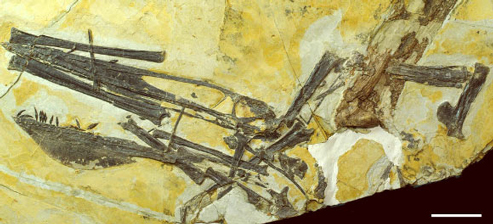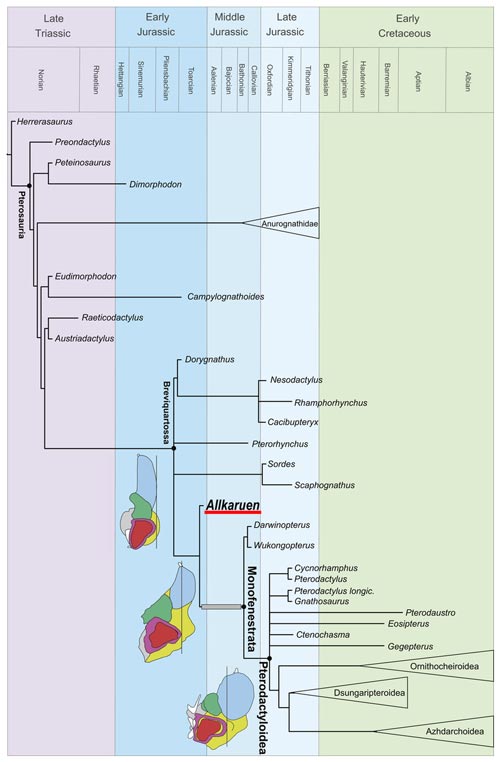The Significance of the Pterosaur Allkaruen
A few days ago, Everything Dinosaur featured an article on this blog about a newly described Early Jurassic pterosaur named Allkaruen koi. We were subsequently emailed by one young dinosaur fan asking us to explain the significance of this fossil discovery. Why was the pterosaur Allkaruen important?
Time to Get Excited About Pterosaurs – Learning Lots about Flying Reptiles
Picture credit: Scientific Reports/Xiaolin Wang et al
The photograph above shows the fossilised remains of Ikrandraco avatar, a new species of pterosaur described in 2014.
To read our recent article on the discovery of a new pterosaur (A. koi) from Patagonia (Argentina): New Long-Tailed Pterosaur from Patagonia.
Pterosaur Fossils are Exceedingly Rare
Fossils of flying reptiles are exceedingly rare, of the 130 or so genera described to date, most are known from only a few fragmentary fossils, mere scraps of bone and teeth. The light, delicate, pneumatic bones of pterosaurs rarely survive the ravages of time and the fossilisation process. Most corpses, don’t even get buried, the chances are the carcase would have been scavenged long before it settled on a lake bed or the bottom of a shallow sea.
Therefore, the naming of a new flying reptile species is, in itself, a significant event. For Allkaruen koi, even more so, as the rocks in southern Argentina where the fossilised bones were found indicate that this flying reptile lived around 180 million years ago.
For models and replicas of pterosaurs and other prehistoric creatures: CollectA Deluxe Scale Prehistoric Animal Models.
A Beautiful Braincase
The new pterosaur genus has been erected after careful study of the skeletal elements including an almost perfect, three-dimensionally preserved braincase. Most pterosaur fossils are crushed, distorted or compacted but not in this case, one of just a handful of very well-preserved flying reptile braincases known in the fossil record. The braincase of Allkaruen shows a unique combination of characteristics of both the Rhamphorhynchoids (non-monofenestratan breviquartossans) and the Pterodactyloidea – let’s explain what this means.
The Pterosauria – the Order of reptiles that includes all these flying reptiles can be split into to distinct and very different groups.
- Formerly referred to as the Rhamphorhynchoids (as the very well known Rhamphorhynchidae family is included in this group), but now known to include a number of other pterosaur families that evolved in the Triassic and the Jurassic, characterised by long-tails and a lengthy fifth digit.
- The Pterodactyloidea essentially the vast majority of known pterosaurs, a Jurassic/Cretaceous radiation of flying reptiles with thin bone walls, relatively long metacarpals and much shorter tails.
The Pterosaur Allkaruen
So, in short, the researchers have a braincase from an Early Jurassic pterosaur that shows features of both groups, the basal group and the later, short-tailed, long toed, thin bone walled Pterodactyloidea. By studying the braincase of Allkaruen the palaeontologists can learn more about how the Pterodactyloidea evolved. They can see how the brains of flying reptiles changed over time.
A Phylogenetic Assessment of Allkaruen Compared to Rhamphorhynchus and the Later Pterosaur Anhanguera
Picture credit: PeerJ
The researchers compared the changing shape and structure of pterosaur brains, comparing Allkaruen with the brain anatomy of Rhamphorhynchus (representing the basal group), with the brain anatomy of a later Cretaceous pterosaur Anhanguera, a representative of the short-tailed Pterodactyloidea. Allkaruen could be described as a sort of “halfway house” between these two groups, a snapshot in pterosaur evolution permitting scientists to gain “insights into the origin of the Pterodactyloid neurocranium and improve our understanding of the tempo and mode of pterosaur evolution.”
The scientists mapped the various elements of the brain by comparing the braincases of these three pterosaurs, from this information they could plot the evolution of the inner ear, essentially the balance organ, vital if you are going to spend a long time in the air.
A Larger Brain Volume
The brain volume of Allkaruen is much bigger than that of Rhamphorhynchus and from this it can be inferred that Allkaruen was a more advanced animal capable of better co-ordinated flight and faster reactions than the Rhamphorhynchidae. The cerebellum (show in yellow in the three brain diagrams included in the picture above), is much larger in Allkaruen than it is in Rhamphorhynchus. The cerebellum in vertebrates is found towards the back of the brain it coordinates and regulates muscular activity. A bigger cerebellum is another indicator that Allkaruen was a better flyer than the more basal pterosaurs. This and other evidence is helping palaeontologists to understand more about how the pterosaurs evolved.
That’s why this fossil discovery is so important.
Visit Everything Dinosaur’s award-winning website: Everything Dinosaur.








Leave A Comment